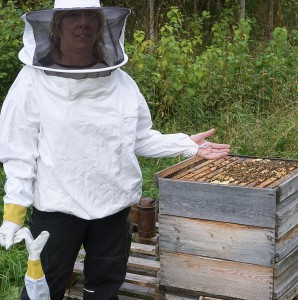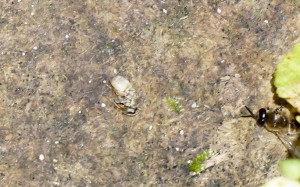 Karin is a new beekeeper. She got thrilled when I took the feral swarm from the wall in one of her houses, so she wanted to keep bees. And got a daughter queen from the feral swarm. She is very happy with that. GM in Germany got one daughter too to this swarm. It’s the one with him that has no mites in the natural downfall.
Karin is a new beekeeper. She got thrilled when I took the feral swarm from the wall in one of her houses, so she wanted to keep bees. And got a daughter queen from the feral swarm. She is very happy with that. GM in Germany got one daughter too to this swarm. It’s the one with him that has no mites in the natural downfall.
I make queens for my own beekeeping operation in first place. I make some more to share with other beekeepers, selling them in Sweden and other European countries. I appreciate feedback from those I sell to. I hope it can help me in my work developing the Elgon bee.
One of the beekeepers I get feedback from is GM in Germany (of some different reasons he just now doesn’t want to use his name). He got some queens in 2014 and some in 2015.
He doesn’t like to treat bees with chemicals and looked for alternative ways of treatment free beekeeping. He wanted to start with queens that probably had better resistance traits than average against the Varroa mite.
He has one apiary at his home. Also he has a couple of new places relatively isolated from other bees. There are some colonies of Carnica bees not far from his home apiary. And quite some Buckfast colonies about 1 km away. So his home yard is not isolated.
One of the Elgon queens he got in 2014 was very promising with lowest natural mite downfall per day and good vitality compared to all his other hives. He succeeded in getting a few daughters from this queen. The original good queen was lost in a pesticide incident in May 2015.
In 2015 GM got some more Elgon queens. He also catched some carnica swarms. He wintered 15 colonies in 2015. In his home apiary he placed many new smaller colonies. He placed his new Elgon queens and daughters of the best one from 2014 in splits in his home apiary. All colonies in his home apiary are established on small cells, 4.9 mm. None of the colonies here was treated with chemicals, organic or not, against the Varroa in 2014 or in 2015. In autumn in 2014 he made a capped brood removal (both worker and drone), but not in 2015.
GM says it’s essential in treatment free beekeeping to have an understanding of the resistance status of the colonies to be able to act at the right time in a right way. Therefore during the second half of the season of 2015 he counted the daily natural downfall of mites in his home apiary. Each month he counted the downfall several times. Of the resulting daily downfalls, he calculated an average for each month.
GM finds mite count of natural downfall to be a tool for judging the resistance quality. Other tools he finds valuable are looking at hygienic behavior concerning mites in worker and drone brood, eventual presence of wingless bees (DWV), ability to produce drone brood late in season and ability to draw small cell foundation (4.9mm) correct.
 This is sometimes called bald brood, a type of hygienic behaviour. The bees are identifying capped brood with mites and uncap such cells, sometimes recap them and uncap again, sometimes keep them this way, sometimes clean out the infested cells. As can be seen there are pupae in the uncapped cells, one almost mature. Bald brood can be seen together with colonies showing high VSH%, also with colonies with lower VSH. VSH can maybe be seen as a special case of this kind of hygienic behavior, uncapping and cleaning capped brood cells in which a mite has offspring. This is a daughter colony of a colony with high VSH.
This is sometimes called bald brood, a type of hygienic behaviour. The bees are identifying capped brood with mites and uncap such cells, sometimes recap them and uncap again, sometimes keep them this way, sometimes clean out the infested cells. As can be seen there are pupae in the uncapped cells, one almost mature. Bald brood can be seen together with colonies showing high VSH%, also with colonies with lower VSH. VSH can maybe be seen as a special case of this kind of hygienic behavior, uncapping and cleaning capped brood cells in which a mite has offspring. This is a daughter colony of a colony with high VSH.
 Observing cleaned out pupae is most probably a sign of the colony showing some kind of hygienic behavior towards Varroa mites in the colony.
Observing cleaned out pupae is most probably a sign of the colony showing some kind of hygienic behavior towards Varroa mites in the colony.
GM focus on identifying the best colonies concerning resistance traits (for breeders next year), the loosers which will be requeened as soon as possible and the medium performers that maybe have a chance to learn how to fight the mite properly. Keep a special eye on those one he says, if they adapt well.
| Average | E1 (S241) | E2 (S241) | E3 (C243) | E4 (F1 of 242) | E5 (F1 of 242) | C1 | X1 |
| Aug-15 | 1 | 6 | 0 | 2 | 3 | 10 | 1 |
| Sep-15 | 1 | 24 | 0 | 4 | 2 | 11 | 2 |
| Oct-15 | 1 | 3 requeened | 0 | 15 | 1 | 16 | 4 |
| Nov-15 | 1 | 13 | 0 | 8 | 1-2 | 14 | 2 |
| Dec-15 | 1 | 1 | 0 | 2 | 1 | 5 | 1 |
| Jan-16 | 0 | 0 | 0 | 1 | 0 | 6 | 0 |
The table is showing the average monthly natural downfall of mites, August-2015 – January-2016. E3 has a sister queen to the one in Karin’s hive.
About 25% of the mites from C1 (only from C1) at the end of December and January were lighter colored young mites pointing to brood in the colony. The table shows the monthly average daily downfall of mites from the colonies in the home apiary. (E2 was moved to another apiary and combined in late October.) GM used the overwintered Carnica colony, C1, to make many splits during 2015. This colony showed some DWV-bees (crippled wing bees) in early spring. They disappeared later, probably with the help of making many nucs and the appearance of drone brood. This colony also showed some hygienic behavior, uncapping brood with mites.
X1 is a swarm (looked like a mix of Carnica and Buckfast) he catched 2015 and hived on drawn small cell 4.9 comb. E4 and E5 have daughter queens of his Elgon queen from 2014. E1 and E2 had sister queens from 2015. E3 is a daughter (2015) from a feral colony in Sweden highly influenced of Elgon heritage.
You can speculate if the figures of E2 are a result of mites coming with the split from the C1-colony, from mites from the neighbor’s bees or less good genetics, or a combination. In any case the colony shifted its queen in late in autumn, and succeeded in getting mated in early October (maybe with Buckfast drones, as Buckfast colonies more often have drones later than Carnica)! The colony E2 was now small and was united with a small colony in another apiary. E2 had initially a few DWV-bees.
E1, E3 and E5 especially, seem to be interesting to watch the development of in 2016, test for VSH and maybe breed from.